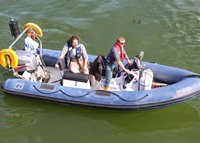Computer vision and robotics used to survey Cardigan Bay

Matt Pugh (left) and Phil Hughes on board a Friends of Cardigan Bay dingy
26 March 2015
Scientists at the Department of Computer Science at Aberystwyth University have been working with marine conservation group Friends of Cardigan Bay to develop better techniques for studying the seabed which is vital for marine conservation and fisheries management.
Cardigan Bay is renowned for its populations of dolphins and porpoises.
Until recently the work of mapping and recording the sea bed had been done using the traditional “researcher and clipboard” technique which is costly and time consuming.
The project has been looking at how video images of the sea floor can be reviewed by utilising computer software programs that is challenging in its own right. This will then be used to assist conservationists to classify the different habitats.
The work was undertaken by postgraduate student Matt Pugh, marine expert Phil Hughes from Friends of Cardigan Bay, and Dr Bernie Tiddeman and Dr Hannah Dee from the University’s Department of Computer Science.
Phil Hughes said: “The initial idea was that computer vision and machine learning techniques could give a new perspective upon the analysis of undersea video.
Dr Hannah Dee said: “The key question we wanted to address was that of “substrate classification”. Put simply, can we wave a video camera around underwater, and map the seafloor from the video we get back?
“Natural Resources Wales have a classification system which categorises the seafloor into a number of different classes, from fine sands to rocky areas. We wanted to create a simplified version of this using modern technology, and ensure that visually similar areas fell into the same categories.
“Once we had completed this phase, the next challenge was to analyse underwater video collected by Friends of Cardigan Bay and Bangor University to try to build a classification automatically.”
The results of the study were presented by Matt Pugh at an international conference in Stockholm, Sweden.
Hannah added: “The project obtained good classifications and was a major achievement considering it was a one year project.”
The team are now looking at novel ways of acquiring undersea video.
A kit robot, Open ROV, has been built and tested in a nearby lake. Operated from a laptop, usually from a boat on the surface, the robot can navigate its way around the seafloor, and uses lights and cameras to record the submarine world.
The team hope that the robot will be ready in the summer for data collection.
Phil Hughes said: “From a Friends of Cardigan Bay point of view, we have been delighted to have supported this work in its infancy. For this coming year we will be concentrating on obtaining much better quality sea bed video for future projects involving computer vision.”
“It is hoped that this combined with the robotics side could be developed further which would change significantly how current data is obtained. This currently involves the use of a survey vessel, creates a huge carbon footprint, and hours of a person’s time to sit down and evaluate the videos produced. “
“It has been a pleasure to work with the Department of Computer Science on a very worthy project and we look forward to future collaborations.”
The one year project was jointly funded by a Knowledge Economy Skills Scholarships (KESS) scholarship and Friends of Cardigan Bay.
Matt Pugh is now studying for a PhD at Edinburgh University but the work continues under the guidance of Dr Bernie Tiddeman and Dr Hannah Dee from the University’s Department of Computer Science.
Hannah added: “For a one year project, the KESS funding has provided closer links between a local NGO and Aberystwyth University, whilst also pushing back the science of underwater monitoring, and providing Matt with a solid research foundation upon which to build his doctorate.”
AU4114



